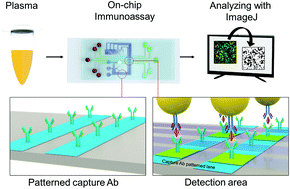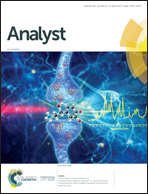On-chip plasmonic immunoassay based on targeted assembly of gold nanoplasmonic particles†
Abstract
Developing a sensitive and selective detection platform of disease-related biomarkers is important for the diagnosis and treatment of diseases at an early stage. Among clinically meaningful biomarkers, proteins are the most commonly used indicators, and they are generally detected via immunoassays. However, the use of conventional immunoassays in early diagnosis is hindered by the time required, complex steps, high-cost, and insufficient sensitivity and selectivity. Herein, we developed a novel on-chip immunoassay with degassing-driven microfluidic devices and gold nanoplasmonic particles (GNPs). To recognize target proteins, antibody-conjugated GNPs as probes were used in the assay owing to their excellent scattering properties. Using the proposed nonenzymatic immunoassay, we detected amyloid β (Aβ) and Tau proteins, representative biomarkers of Alzheimer's disease, in femtomolar levels. Selective and quantitative detection of Aβ spiked in blood plasma was also achieved for further clinical application of the proposed immunoassay. The proposed plasmonic immunoassay integrated with degassing-driven microfluidic chips provides a new platform for biological assays and diagnosis.



 Please wait while we load your content...
Please wait while we load your content...